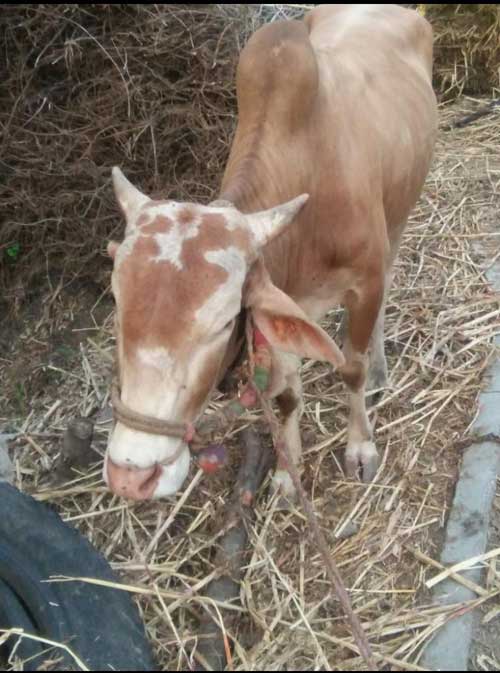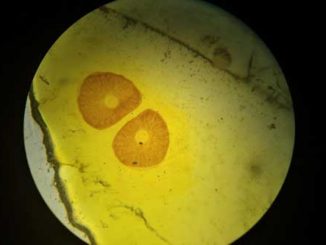Introduction
Asymmetry of facial expression is frequent with unilateral lesions of the facial nucleus or nerve in most species. Facial paresis is reduced movement of the muscles of facial expression and indicates milder nucleus or nerve involvement. The nucleus of the facial nerve is located in the rostral medulla oblongata of the brain stem (Merck, 2008). Paralysis denotes a state, there is incomplete or complete loss of nervous control over any bodily functions. This may involve loss of sensory or motor power or both. The facial nerve paralysis has been reported in horse (Rand et al, 2012), in cattle (Saikia et al., 2018) in buffalo (Chaudhary et al., 2012) and in camel (Anita Meena et al., 2012).
Case history and Clinical observation
A six year old non-descript bullock was referred to the Department of Veterinary Medicine, COVAS, Parbhani with a complaint of lacrimation, inappetance, drooping of left ear and nostril. Detailed clinical examination indicated drooping of left ear, eyelid and nostril, unilateral lacrimation (Fig.1). On neurological examination, menace reflex revealed no movement of left ear, palperal and corneal reflexes were sluggish of left ear, no ear prick response, lack of tonicity in facial muscles of left side, abnormal jaw movements and asymmetry of muscle contraction of face. Examination of mouth cavity revealed no any accumulation of cud between left cheek and molars. All the physiological parameters viz; rectal temperature, respiration and heart rate were within the normal range. On the basis of history, clinical signs and neurological examination case was diagnosed as unilateral facial nerve paralysis of left side.

Treatment and Discussion
The bullock was treated with Inj. Ceftrixone @10 mg/kg BW IM and Inj, Flunixin meglumine @ 1.1 mg/kg BW IM for five days, injection Tonophospon 15 ml IM on alternate days three doses, nervine tonic (Inj. Tribivet) @ 5ml IM for seven days. To stimulate the facial nerve infrared therapy was given around the base of ear and cheek for three minutes for seven days and local massage. On 3rd day of treatment animal started movement of ear (Fig. 2), increase in feeding and watering intake. By 7th day bullock started movement of ear and opening and closing of upper eyelid with normal movement of eye, eyelid and left ear.

Clinical signs of facial paralysis fluctuate with the location, severity and chronicity of the lesion. Trauma is a most common cause of facial paralysis in all species. If a unilateral lesion is located in the facial nucleus or proximal portion of facial nerve, paresis or paralysis of the eyelid, ear, lips and nostrils on that side are seen (Merck, 2008). The left sided drooping of ear, eyelid, upper lip, abnormal swelling of left cheek were noted in unilateral facial nerve paralysis in buffalo and was successfully treated with Inj. Prednisolone and Inj. Tribivet (Chaudhary et. al. 2001). Usually nervine disorders take longer time to recover, some require two weeks or may take months, sometimes there may not be any response to treatment. In present case bullock showed completely recovery after 7th day with normal feeding and watering with movement of ear and eyelid of left ear.
References:
- Anita Meena, Aditya Midha, Kapil Kachwaha, Mahendra Tanwar, Mukesh Gahlot, P.C. Parasar and T.K. Gahlot (2010) Unilateral facial nerve paralysis in a dromedary camel. Journal of Camel Practice and Research. 19 (2):287-288.
- Chaudhary, Sunil, V. S. Dabas, J. N. Mistry and K. P. Singh (2001) Unilateral facial nerve paralysis in a Mehsani buffalo-A case report. Indian J. Anim. Res. 35 (2):159-160.
- Merck (2008) The Merck Veterinary Manual. 8th Edn. Merck & CO., INC. Whitehouse station, N.J. USA.
- Rand C.L., Hall T.L., Aleman M. and Spier S.J. (2012). Otitis media-interna and secondary meningitis associated with Corynebacterium pseudotuberculosis infection in a horse. Equine Vet. Education. 24(6):271-275.
- Saikia Khandia, Sakhare, M.P., Siddiqui, MFMF and Bangar, S.R. (2018) Unilateral facial nerve paralysis in a non descript bullock. The Blue Cross Book, 37 (1): 118-119.
- Tyagi, R. P. S. and Singh, J. (1993) Ruminant Surgery. I edn. CBS Publishers and Distributors, Delhi. Pp-388-389.
|
The content of the articles are accurate and true to the best of the author’s knowledge. It is not meant to substitute for diagnosis, prognosis, treatment, prescription, or formal and individualized advice from a veterinary medical professional. Animals exhibiting signs and symptoms of distress should be seen by a veterinarian immediately. |






Be the first to comment